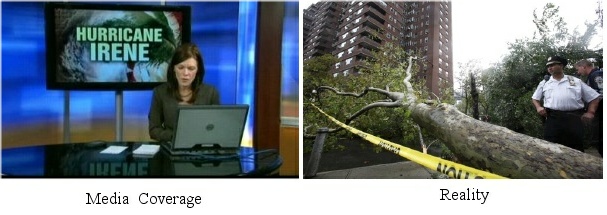Predictably,the criticism that followed the media’s doomsday weather frenzy was in itself out of proportion. For example, media critic Howard Kurtz wrote:
Someone has to say it: cable news was utterly swept away by the notion that Irene would turn out to be Armageddon. National news organizations morphed into local eyewitness-news operations, going wall to wall for days with dire warnings about what would turn out to be a Category 1 hurricane, the lowest possible ranking.Hindsight is twenty-twenty, but there is much more at work here. Looked at in evolutionary terms, the media is only giving people what they want: news that will shock and frighten them.

We human beings cannot help but give our attention to objects in our environment that seem to be threatening, a concept that is known as negativity bias. Hardwired into our brains at the deepest level is a fixation on things that are dangerous. All things being equal, we are much more likely to pay attention to potential threats than to potential benefits. This imbalance illustrates the “better safe than sorry” aspect of natural selection.
In terms of survival, the cost of a misstep can be very high—even death. The benefit of doing something right, on the other hand, is simply the ability to continue moving forward. Developed over hundreds of millions of evolutionary years, your brain has a keen interest in being aware of potentially dangerous stuff. It can’t help it. This cautionary mechanism has been at work in animals since the beginning of time, and humans are no exception.
Programmed by evolution to have a bias towards negative information, we find scary, dangerous information much more interesting than positive, happy information. We may not like it, but we’re helplessly fascinated by it. News organizations may not know much about evolution, but they certainly understand numbers. The more they play up the fearful, terrifying aspects of the news, the more viewers they gain.
Negativity bias is just one of the many ways our brain alters information about the outside world in order to fulfill an evolutionary agenda. Having successfully evolved this protective stance, our brains, however, haven’t developed the capacity to immediately comprehend the antidote: filtering the facts to understand the math behind the meaning. Only a few thousand people out of a population of 350 million get hit by hurricane disaster every year, yet the news coverage given to the potential for damage, combined with negativity bias and our imaginations, render these weather patterns urgent and dangerous.
To the appearance of danger, our body reacts with very real, very understandable, and completely unnecessary fear.
Read more from Michael W. Taft and co-author Peter Baumann at Ego.




Comments